|
|
|
Overlooked by the tall tower of it old university, Coimbra stands on a hillside overlooking the Mondego river. Many poets, inspired by the romantic setting, have immortalized the charm of the city, the first capital of Portugal and have helped make it the center of fine arts and letters. There is a popular saying that the Portuguese pray in Braga, work in Porto, Govern in Lisbon, play in the Algarve, and study in Coimbra.
|
|
|
The best views of Coimbra are from across the river in Santa Clara. Although the town has spread substantially over the recent decades, the center is still distinctively divided into the upper town (the Alta) which is traditionally the university and episcopa quarter, and the lower town (the Baixa) or shopping area.
|
|
|
Source, Michelin Tourist Guide Book
|
|
|
The chapel for the Coimbra 2nd and 3rd branches is one of the oldest chapels of the Church in Portugal. The chapel is converted from a home perched on the crest of a hill overlooking the southern valleys of the City of Coimbra
|

Click to enlarge |
|

Click to Enlarge |
The back side of the Coimbr 2 chapel shows the beautiful architecture of the chapel. The large bay window shown in the picture makes a pleasant alcove in the back of the chapel which is on the ground floor from the rear of the chapel. The entrance is on the second level as viewed from the back. The back portion of the chapel includes a large garden area on the steep slopes.
|
|
|
The chapel at Penedo da Saude has a room that serves as cultural hall. It has a small stage with curtains. During the zone conferece near Christmas of 1996, a Nativity play was presents in on this stage.
|

Click to enlarge |
|

Click to enlarge |
The chapel for the Coimbra 1st branch was one of the few chapels that was constructed by the church specifically to be used as a chapel. This is an older photo. In recent years the landscaping has been improved.
|
|
|
Lunch as a zone conference at the Coimbra 1 chapel. This day was a pot luck event, a break from the ham and cheese sandwiches. Sisters Melo and Eliason enjoy the selection. Sister West's cinnamon rolls were always a hit.
|
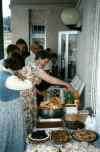
Click to enlarge |
|

Click to enlarge |
This is a picture of the Relief Society/Kitchen of the Coimbra 1 chapel. In this chapel, the kitchen was at the back of the Relief Society room. A preciana (curtain) could be lowered to enclose the kitchen area when not in use. In this picture several missionaries including Elders Weir and Malmstrom and Sister Peterson and Cartwright are preparing some goodies for a zone conference.
|
|

Click to enlarge |
A seminary graduation was held in the Coimbra 1 chapel. This is a picture of the graduates taken in the chapel.
|
|
|
Santa Clara is located across the river from Coimbra but is part of the Coimbra metropolitan area. The Chapel is in the first floor of an apartment builder. President Alves, district president of the Coimbra District is standing next to President West.
|

Click to enlarge |
|
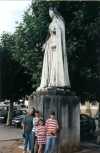
|
The convent of Santa Clara is also the final resting place of Santa Isabel. This is a picture of a statue of her in front of the chapel dedicated to her. The chapel contains her remains in a crystal sarcophagus.
|
|
|
Portugal dos Pequenitos (Portugal for the little ones) is a famous tourist attraction in Coimbra. It is actually located across the river in Santa Clara. The main draw is the many famous buildings from Portugal are reproduced with amazing detail but on a small scale. Consequently, children appear as giants and can tour most of Portugal in an hour.
|
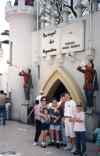
|
|

Click to enlarge |
Both of these pictures are of the University in Coimbra.The one on the left is the version at Portugal dos Pequenitos.The version on the right is the real thing.The people in both pictures are the same.The University of Coimbra is the oldest university in Portugal and one of the oldest in Europe. |

Click to enlarge |
|
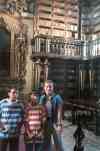
Click to Enlarge |
The old library at the University of Coimbra was built in the early 1700´s during the rein of João V. The library consists of three large rooms with rich wood carving and furnishings. My first impression of the library was that I had stepped into the library depicted in the movie "Beauty and the Beast." A little know fact is manner to controling insects. During the day, bat hide in the deep resesses of the carved wood. At night the bats clear out all the insects.
|
|
|
The Botanical Gardens are part of the University of Coimbra. This is a wonderful place to enjoy nature and for an impromptu LDS Choir. During a district leaders conference, we took a break to visit this garden. The setting inspired the missionaries to sing a few songs. Not only did the missionaries enjoy it, but so did the many people passing through.
|

Click to enlarge |
|
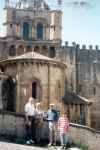
Click to enlarge |
The old cathedral was commissioned by King Afonso Henriques (the first king of Portugal) when Coimbra was the capital of Portugal. At the time it stood on the border between the Christian and the Muslim words, which explains it fortress-like appearance. the cathedral was Portugal´s first, built between 1140 and 1175.
|
|
|
Just a few miles south of Coimbra are the ruins of a Roman city, Conímbriga. The mosiac floors of the homes are beautifully preserved. The city was founded in the first century AD and remained prosperous over a long period of time. In the 3rd century, the city was threatened Barbarian invasion, resulting in part of the city being fortified with part remaining outside the walls.
|

Click to enlarge |
|

Click to enlarge |
About 30 minutes north of Coimbra lies the Buçaco National Forest near the town of Luso (Location of a famous brand of bottled water.) The park crowns the northern most peak of the Serra do Buçaco. The entire park is enclosed by a stone wall with just a few entrances. In the center of the forest stands a castle like palace hotel built in 1900 of an unusual design. Originally, the park was the home of sixth century Benedictine monks.
|
|

